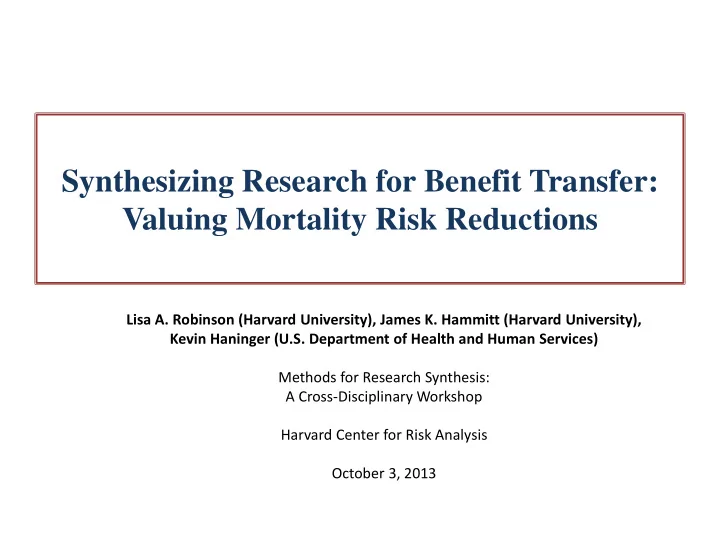

Synthesizing Research for Benefit Transfer: Valuing Mortality Risk Reductions Lisa A. Robinson (Harvard University), James K. Hammitt (Harvard University), Kevin Haninger (U.S. Department of Health and Human Services) Methods for Research Synthesis: A Cross-Disciplinary Workshop Harvard Center for Risk Analysis October 3, 2013
Contents • Context • The Benefit Transfer Framework • Current Practices • Four Questions: – Evaluation criteria – Characteristics of problem and data – Strengths and limitations of outputs – Research needs Harvard Center for Risk Analysis
Context • The goal: – Estimate whether the benefits of a policy exceed its costs. • The question: – How to synthesize research to value benefits when studies of similar, but not identical, outcomes are available. • The example: – The value individuals place on small reductions in their own mortality risks (the value per statistical life or VSL). Harvard Center for Risk Analysis
Context • Three options: – Conduct new primary research • Lack time, money; need to make a decision. – Exclude the outcome from the analysis • Difficult to determine whether subjective judgments are within a reasonable range. – Apply the available research, using the “benefit transfer” framework. • Evaluate for suitability and quality. • Assess implications of uncertainty. Harvard Center for Risk Analysis
The Benefit Transfer Framework (1) Describe the Policy Scenario (2) Identify Potentially Relevant Existing Valuation Research (3) Review Existing Studies for Quality and Applicability (4) Transfer the Estimate(s) (5) Address Uncertainty Harvard Center for Risk Analysis
The Benefit Transfer Framework • VSL = an individual’s willingness to pay (WTP) for a small annual change in his/her own risk, divided by risk change. – If $900 = individual WTP for a 1/10,000 annual mortality risk change, – then VSL = $9 million ($900 ÷ 1/10,000). • Not the value of saving an individual’s life with certainty. Harvard Center for Risk Analysis
The Benefit Transfer Framework • Types of data – Revealed preference methods use market transactions or observed behavior to estimate the value of related goods; • e.g., changes in wages associated with changes in job- related risks, controlling for other influencing factors. – Stated preference methods ask respondents to report their WTP under hypothetical scenarios. Harvard Center for Risk Analysis
Current Practices • Federal agencies currently use point estimates from selected studies; most address job-related risks. – EPA VSL based on 26 values from 1992/1993 literature review. • Substantial work on alternatives, expert panel guidance. – DOT VSL based on 9 values from 2013 literature review . • In 2012 dollars: – EPA’s estimate is $9.2 million; – DOT’s estimate is $9.1 million. Harvard Center for Risk Analysis
Current Practices • Why not other methods? – Available meta-analyses criticized for study selection criteria and statistical methods. • Evolving best practice standards for primary research. – Structural models , that combine theory and data from multiple sources, are in need of further refinement. – One expert elicitation , has not yet gone beyond the pilot stage. Harvard Center for Risk Analysis
Criteria for Applicability of Synthesis Methods • Validity: – Difficult to determine. • Compare to well-conducted primary research study. – Likely to vary across applications. • Depends on: – The quality of the primary research. – The similarity of the study and policy outcomes. – The extent to which the study results can be adjusted to fit the policy outcome. Harvard Center for Risk Analysis
Criteria for Applicability of Synthesis Methods • How does uncertainty in the benefits estimates affect: – The estimates of expected net benefits for individual policy options? – The estimate of which option is likely to lead to the largest net benefits? • In some cases, effect may be minimal; it may be substantial in others. Harvard Center for Risk Analysis
Suitability of Synthesis Methods • Use of individual studies or meta-analysis appropriate when: – study and policy scenario are similar, – primary research includes variables that can be used to adjust results; • e.g., meta-regression to estimate effect of age, disease severity, on values. Harvard Center for Risk Analysis
Suitability of Synthesis Methods • Use of structural models appropriate when: – Theoretical relationships are relatively unambiguous. – Data are available for estimation. – Few cases may fall into this category. • Use of expert elicitation useful when: – Some research available, inconsistent results. – Many cases may fall into this category. Harvard Center for Risk Analysis
Strengths and Limitations of Outputs • Regardless of method, need clear and transparent discussion/assessment of: – quality of primary research; – effect of scenario differences. • Also quantitative uncertainty analysis: – Breakeven; – Sensitivity; – Probabilistic. Harvard Center for Risk Analysis
Research Needs • More “best practices” primary research studies. • Continued work on best practice standards. • Consistent reporting standards for primary research studies. • New, improved meta-analyses. • More work on structural modeling and expert elicitation. Harvard Center for Risk Analysis
Recommend
More recommend